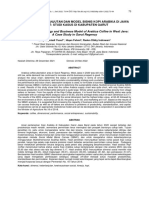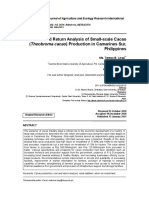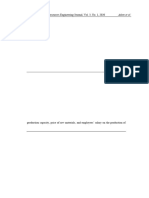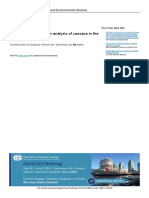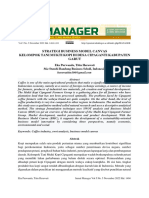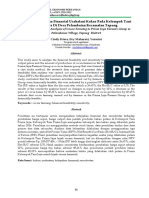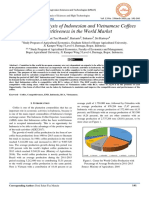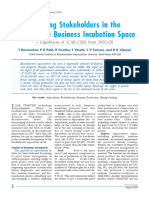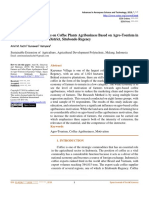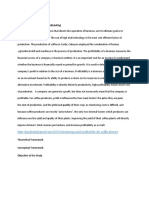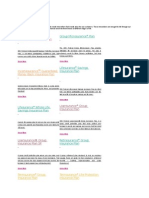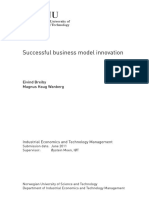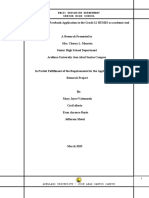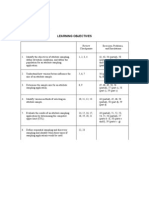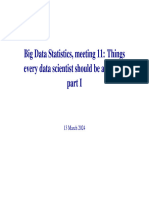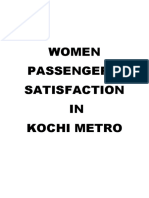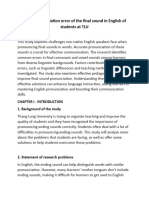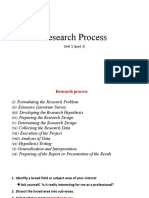7 Final REV+ +Eka+Martiningsih+Et+Al AgBioForum
7 Final REV+ +Eka+Martiningsih+Et+Al AgBioForum
Uploaded by
Fernanda LopesCopyright:
Available Formats
7 Final REV+ +Eka+Martiningsih+Et+Al AgBioForum
7 Final REV+ +Eka+Martiningsih+Et+Al AgBioForum
Uploaded by
Fernanda LopesCopyright
Available Formats
Share this document
Did you find this document useful?
Is this content inappropriate?
Copyright:
Available Formats
7 Final REV+ +Eka+Martiningsih+Et+Al AgBioForum
7 Final REV+ +Eka+Martiningsih+Et+Al AgBioForum
Uploaded by
Fernanda LopesCopyright:
Available Formats
AgBioForum, 25(2): 61-71.
©2023 AgBioForum
Investment in Coffee Farming Based on Community Encouragement
Ni Gst Ag.Gde Eka Martiningsih* The primary objective of the study conducted in the Kintamani
Faculty of Agriculture and Business, District of Bali was to evaluate the economic viability and financial
Mahasaraswati University Denpasar, Bali, Indonesia feasibility of engaging in Arabica coffee cultivation. Additionally,
Email:ekamartini@unmas.ac.id the research sought to investigate the possibility of leveraging
Arabica coffee production as a means to attract tourists to the
region. A rigorous data analysis methodology was implemented,
I Ketut Arnawa commencing with the identification of a sample of 100 farmers
Faculty of Agriculture and Business, through the utilisation of a multistage sampling technique to
Mahasaraswati University Denpasar, Bali, Indonesia guarantee inclusivity of the wider population. The assessment of
Email:arnawaiketut1962@gmail.com profitability was conducted with a high degree of rigour, wherein
the present value of both the benefits and costs related to Arabica
I Made Budiasa coffee farming were thoroughly compared. The assessment of
Faculty of Agriculture and Business, financial feasibility involved the utilisation of key metrics, namely
Mahasaraswati University Denpasar, Bali, Indonesia the Net Benefit Cost Ratio (Net B/C), Net Present Value (NPV),
Email:mdbudiasa43@gmail.com and Internal Rate of Return (IRR). The metrics presented offer
quantitative insights, indicating that returns on investment in
Arabica coffee farming become evident within the period spanning
*Corresponding author: from the fourth to the thirtieth year. The net benefit-cost (B/C) ratio
Ni Gst Ag.Gde Eka Martiningsih; was calculated to be 4.443, indicating a favourable financial
Email: ekamartini@unmas.ac.id outcome for the venture. Additionally, the venture exhibited a
positive net present value (NPV) of Rp. 107,672,034 and an
impressive internal rate of return (IRR) of 35.06%. These findings
confirm the financial viability of the project. The findings of this
study indicate that a majority of the farmers surveyed (85%)
expressed a favourable attitude towards the establishment and
growth of coffee tourism destinations. These insights were
obtained through the use of qualitative research methods,
specifically in-depth interviews conducted with a sample size of five
informants. This study offers essential insights for farmers and
prospective investors pertaining to investment expenditures,
economic feasibility, and profitability prospects in the cultivation of
Arabica coffee. Furthermore, this highlights the potential
opportunities for the development of ecotourism in the Kintamani
region of Bangli, Bali, thereby enhancing our comprehension of the
local economic environment.
Keywords: Arabica coffee, farming, investment, finance, profit,
natural tourism
Introduction coffee farming are comprehensively assessed through the
utilisation of economic theories pertaining to investment,
Coffee is a prominent tropical commodity that is globally cost-benefit analysis, and agricultural economics.
traded, accounting for approximately 50% of total tropical Based on the research conducted by Amanda and Rosiana
commodity exports. The global appeal and widespread (2023), Indonesia's ranking as the fourth largest global
popularity of this phenomenon can be attributed to its coffee producer has been displaced to the fifth position as a
unique flavour profile, which is bolstered by a combination result of a decline in coffee exports. However, Colombia
of historical, traditional, social, and economic influences. surpassed Indonesia in this ranking, causing Indonesia to
Moreover, coffee functions as an inherent reservoir of drop to fourth place among the leading coffee-exporting
caffeine, a compound recognised for its capacity to countries globally. According to the Director General of
activate the brain, augment cognitive functions, and Plantations at the Ministry of Agriculture in 2018,
enhance memory. Additionally, the association between Indonesia is now behind Brazil, Vietnam, and Colombia.
the presence of chlorogenic acid in caffeine and a The decline in coffee production in Indonesia has been
decreased susceptibility to diabetes and heart disease has attributed to climate change, resulting in unpredictable
been established. The global consumption of beverages patterns of rainfall that have adversely impacted both coffee
derived from coffee bean extract is estimated to be production and the well-being of farmers. The coffee
approximately 2.25 billion cups per day, signifying a production in Indonesia in 2021 exhibited a notable surge,
remarkable rate of consumption. According to the marking the highest output achieved in the past ten years
International Coffee Organisation (ICO), in 2015, the (Setyo Andi et al., 2022). The total production volume
estimated global demand for ground coffee was amounted to 774.6 metric tonnes, reflecting a growth rate
approximately 8.77 million metric tonnes (ICO, 2015). of 2.75% compared to the preceding year. The decline in
Coffee occupies a prominent position in the global market coffee production in Indonesia has been attributed to
when viewed through an economic lens. Examining the climate change, specifically the adverse effects of irregular
long-term profitability of coffee cultivation yields valuable rainfall patterns on both coffee cultivation and the well-
insights regarding the economic sustainability of this being of farmers (Sujatmiko & Ihsaniyati, 2018).The lower
agricultural practice. The financial aspects of Arabica productivity of coffee production in Indonesia can be
AgBioForum, 25(2), 2023 | 62
attributed to the continued use of traditional coffee economic development. As per the findings of the
plantation techniques (Baso & Anindita, 2018). Currently, Indonesian Plantation Research and Development Centre,
the average yield of Indonesian coffee stands at 0.552 the Arabica coffee species exhibits an economic lifespan
metric tonnes per hectare, resulting in a total coffee spanning from 20 to 25 years, during which the coffee
production of 685,090 metric tonnes. The coffee plantation plants commence fruit production after a period of 4 to 5
area in Indonesia spans 1,241,710 hectares. In contrast, years. Nevertheless, there exists a specific timeframe in
Vietnam exhibits a coffee productivity rate of 2.175 metric which the optimisation of coffee production may not be
tonnes per hectare, resulting in a cumulative production of achieved, resulting in a decrease in yields as the coffee
1,395,600 metric tonnes, encompassing a coffee plantation plants mature. This issue is further exacerbated by the
area spanning 641,700 hectares. substantial amount of investment capital needed, as
Bali is a prominent coffee-producing region in Indonesia, evidenced by a study conducted by Roidah (2013), which
renowned for its contributions to both the domestic and revealed that it amounts to IDR 20,000,000 per hectare.
international markets, encompassing Asia and Europe. The study's significance is derived from its capacity to
During the initial semester of 2016, Bali generated a total provide valuable insights to a range of stakeholders. The
of US$ 60,131.42 in foreign exchange through its coffee main objective of this study is to evaluate the economic
export endeavours. The quantity of coffee shipments feasibility of investing in the cultivation of Arabica coffee
experienced a notable surge of 146.22%, rising from 5.15 over a significant time frame of 30 years. The findings of
tonnes in the initial six months of 2015 to 12.68 tonnes in this research are of great importance to potential investors,
the corresponding period of 2016 (Bali Provincial Office policymakers, and coffee farmers, as they provide essential
of Industry and Trade, 2016). information that can assist in making well-informed
Bangli Regency is renowned for having the largest coffee decisions. In addition, this study makes a valuable
cultivation area, estimated at approximately 4,736 contribution to the ongoing scholarly conversation
hectares, in comparison to other regencies. Bangli surrounding sustainable agriculture. Specifically, it
Regency, being the foremost producer of Arabica coffee, examines the enduring financial viability of coffee farming
experienced a marginal rise in production from 2,247 and its compatibility with environmental and social
metric tonnes in 2019 to 2,249 metric tonnes in the factors. The study highlights the significance of local
subsequent year of 2020. The Arabica coffee variety that economies and livelihoods by examining particular
is grown in a specific region has been granted regions, such as Bali and Bangli Regency. It provides
Geographical Indication status and is officially recognised valuable insights into the potential of coffee cultivation to
by the Geographical Indication Protection Society (GIPS). drive regional development and generate income.
This particular variety is referred to as "Kopi Arabika Furthermore, the research is in accordance with the
Kintamani Bali" (Ardana, 2019). The cultivation of principles of agricultural sustainability, which is a key area
Arabica coffee is carried out by individuals who are of interest in academic and policy circles. The analysis of
affiliated with the Subak organisation. long-term profitability in Arabica coffee cultivation serves
Based on the findings of a study conducted by Winantara, as a valuable contribution to the discourse surrounding
Bakar, and Puspitaningsih (2014), it has been determined sustainable agricultural practices. The research can draw
that investment in the cultivation of civet coffee in Bali upon theories pertaining to sustainable agriculture, trends
yields a profitable outcome. The study reveals that the in crop yield, and the enduring environmental
internal rate of return stands at 21%, while the economic consequences of coffee cultivation, thereby elucidating the
age is estimated to be 5 years. In a similar vein, Rico, Wan interplay between economic considerations and
Abbas, and Umi (2014) conducted a study that showcases environmental and social factors.
the economic viability of cultivating civet coffee in the The central research inquiry examined in this investigation
region of West Lampung, with positive outcomes observed pertains to the financial viability of engaging in the
at both the micro and macro levels. In a study conducted cultivation of Arabica coffee throughout its 30-year
by Wahyuni, Utama, and Mulyasari (2012), it was economic lifespan. In accordance with the aforementioned
discovered that Arabica coffee, with a projected lifespan of inquiry, the research aims to achieve two primary
10 years, demonstrates a net benefit-cost ratio (B/C ratio) objectives: (1) to examine the cash flow of benefits and
of 2.17, a net present value (NVP) of Rp. 18,847,733, and costs by employing forecasting techniques throughout the
an internal rate of return (IRR) of 26.60%. economic lifespan, and (2) to evaluate the advantages
Within the framework of market dynamics, coffee is associated with the development of Arabica coffee farming
susceptible to variations in worldwide demand and supply. over its entire economic existence, utilising investment
The present study acknowledges the aforementioned criteria such as Net Present Value (NPV), Net Benefit Cost
market dynamics and proposes to incorporate theories Ratio (Net B/C), and Internal Rate of Return (IRR).
from the field of international trade and market analysis. The observed phenomenon in the context of investing in
The objective is to investigate the potential impact of Arabica coffee farming in Bangli is characterised by a lack
changes in the global coffee market on the long-term of comprehensive understanding among practitioners,
profitability of Arabica coffee cultivation. particularly within the coffee farming community
Arabica coffee also experiences notable annual growth in consisting of members affiliated with the Subak
export demand, ranging from 20% to 25%, thereby organisation. Historically, these agricultural communities
establishing itself as a feasible and lucrative avenue for have primarily operated as providers of raw materials, with
Martiningsih, Arnawa, Budiasa — Investment in Coffee Farming Based on Community Encouragement
AgBioForum, 25(2), 2023 | 63
limited participation in the process of making investment component is relevant to both the sustainability of the
decisions. This study is motivated by the need to address a environment and the potential for supplementary
knowledge gap pertaining to the responses and revenue streams for coffee farmers.
expectations of the coffee farming community in Bangli In general, the methodology utilised in this study
with regards to investment in Arabica coffee cultivation. incorporates historical research, archival analysis,
Consequently, a thorough analysis is required to gain literature review, and data analysis techniques to provide a
insights into this matter. comprehensive understanding of the historical origins of
Literature Review coffee and emphasise its global importance. The objective
of this multifaceted approach is to offer a comprehensive
Coffee is a widely cultivated plantation crop with a long and nuanced comprehension of the trajectory of coffee,
history of cultivation and significant economic starting from its origins in Ethiopia and culminating in its
importance. Approximately 70% of global coffee status as a globally traded commodity. Moreover, prior
consumption is derived from the Arabica coffee species, research studies play a crucial role by providing solid
while the remaining 26% is attributed to Robusta coffee. groundwork and offering indispensable contextual
Coffee originates from the African continent, specifically knowledge for the present investigation. The
the elevated terrain of Ethiopia. Nevertheless, global aforementioned studies provide valuable perspectives on
recognition of coffee was only achieved subsequent to its the historical importance of coffee, its botanical attributes,
cultivation beyond its original region of Yemen in southern and the techniques employed in its processing. These
Arabia, facilitated by Arab merchants. The research aspects hold great relevance in conducting a thorough
conducted by Gumulya and Helmi (2017) shed light on the examination of the economic viability of cultivating
historical origins of coffee, revealing its initial cultivation Arabica coffee in Bali for a span of 30 years.
in Ethiopia and subsequent dissemination to global Investment Valuation
markets facilitated by Arab traders. The historical context The cultivation of Arabica coffee can be classified as an
underscored the worldwide importance of coffee agricultural enterprise. Business investment activities are
cultivation. undertaken with the expectation of future outcomes or
The coffee fruit is composed of various components, gains. The Arabica coffee plantation development business
specifically the outermost layer known as the excocarp, entails deriving income from the sale of production, while
a flesh layer called the mesocarp, a mucus-like the investment involved encompasses the costs incurred
substance referred to as musilage, a thin protective skin prior to obtaining these benefits.
known as the spermoderm, and the coffee beans A project proposal is considered feasible or appropriate
themselves, also known as the endoscarp. The when the benefits derived from it outweigh the
outermost layer of the fruit, known as the exocarp, associated costs or sacrifices. Typically, investment
initially appears green in young coffee cherries. As the endeavours within the plantation industry exhibit a
cherries mature, this layer undergoes a colour long-term nature. In this context, the evaluation of
transformation, progressing from green to yellow and advantages necessitates the consideration of time. Both
ultimately turning red when fully ripe. When the fruit receipts and expenses are quantified in monetary terms,
reaches ripeness, its flesh will exhibit a slimy texture thereby necessitating a common measure to determine
and possess a mildly sweet taste. The endocarp, which their equivalence. In this regard, the concept of present
comprises the inner layer of the skin, is characterised by value is commonly employed for such calculations. The
its considerable toughness and is often referred to as concept of present value distinguishes the current worth
horn skin. Mubarok, Suwasono, and Palupi (2014) of money from its future value. The act of determining
offered valuable insights by providing a description of the present value of a future cash flow is commonly
the various constituents of the coffee fruit, which referred to as discounting.
encompassed the horn skin, a resilient inner layer. This The financial viability of an investment can be
knowledge was specifically pertinent in comprehending evaluated using various criteria. Investments serve as
coffee processing techniques, which is a crucial element indicators for measuring and comparing the merits of
for coffee farmers aiming to enhance their different projects. By employing investment criteria, it
methodologies. becomes possible to assess the profitability of a project
The processing of coffee beans can be conducted using (Husnan & Muhammad, 2000). There are three crucial
two distinct methods, specifically the wet method and measures that play a significant role in the evaluation of
the dry method. The dry processing method involves the projects pertaining to discounting principles (Kadariah
direct exposure of coffee cherries to solar radiation for & Gray, 1978; Vawda, Moock, Price Gittinger, &
drying purposes. On the other hand, the wet processing Patrinos, 2003).
method entails a series of sequential stages, resulting in (1) Net Present Value (NPV)
the generation of various forms of waste, such as coffee
skin (also known as coffee pulp), which can be The Net Present Value (NPV) refers to the disparity in
repurposed as animal feed. The study by Nadhiroh present value that arises from comparing the benefits
(2018) examined the production of byproducts like and costs associated with a given project. Similar to the
coffee skin as well as the two main methods of Net Benefit/Cost (Net B/C) approach, the discount rate
processing coffee, wet and dry. The waste management employed represents the opportunity cost of capital. The
Martiningsih, Arnawa, Budiasa — Investment in Coffee Farming Based on Community Encouragement
AgBioForum, 25(2), 2023 | 64
decision-making criterion entails accepting a project if possess a clear comprehension of the objectives
its net present value is positive. The net present value pertaining to development and empowerment (Ife,
(NPV) is deemed to be zero, indicating that the project 2016). The assessment of community involvement in a
generates returns equivalent to the opportunity cost of development activity is contingent upon the
capital. Conversely, if the NPV falls below zero, the significance of the community's response to the
project is deemed unfavourable and thus rejected. development plan.
(2) Net Benefit-Cost Ratio (Net B/C) This study provides novel perspectives on multiple
significant aspects. The initial section of the paper presents
When evaluating the project, it is essential to assess the
present value of both its benefits and costs, and express an innovative investment framework for Arabica coffee
this relationship as a ratio. The discount rate employed cultivation, which incorporates the use of surveys and
typically represents the ratio of capital's opportunity interviews to thoroughly assess its economic viability.
cost. The calculation of the Net Benefit-to-Cost ratio Furthermore, in contrast to numerous studies that primarily
(Net B/C) involves the discounting of gross benefits and examine immediate benefits, the present research
gross costs, which encompass investment costs, investigates the extended financial viability of coffee
maintenance expenses, and operating costs associated cultivation spanning a duration of 30 years, thereby
with production. In the event that the Net Benefit/Cost shedding light on its temporal dynamics. Moreover, this
(Net B/C) ratio exceeds one, the appropriate course of approach adopts a community-centric perspective, taking
action would be to accept the project. Conversely, if the into account the roles and expectations of local farmers and
Net B/C ratio falls below one, it would be advisable to stakeholders rather than solely focusing on financial
reject the project. considerations. Furthermore, the system acknowledges the
(3) Internal Rate of Return (IRR) ecological consequences, particularly in mountainous
The term "internal rate of return" refers to a criterion that areas susceptible to landslides, underscoring the
remains unaffected by external factors such as fluctuations significance of implementing sustainable methodologies.
in interest rates or inflation rates. The Internal Rate of The present study investigates the potential of coffee
Return (IRR) is a financial metric employed to determine tourism as an innovative area of research that extends
the interest rate at which the present value of costs and beyond conventional agricultural studies. It aims to
benefits is equal. In order to optimise the economic identify novel approaches for enhancing local economies
evaluation of the project, it is desirable for the Net Benefit- and advancing environmental sustainability within the
to-Cost ratio (Net B/C) to approach unity, the Net Present context of coffee farming. Collectively, these distinctive
Value (NPV) to approach zero, and for the net benefit elements offer a comprehensive and invaluable viewpoint
amount to be positive. The calculation of the internal rate on the cultivation of Arabica coffee.
of return (IRR) typically involves a trial-and-error Research Methods
approach, as there is no readily available mathematical
formula that can be employed for this purpose. Initially, a Location and Time
specific interest rate is selected for the purpose of
computing the net present value (NPV). If the resulting The study was carried out among coffee farmers
NPV is positive, subsequent attempts are made using a cultivating Arabica coffee in the villages of Serahi,
higher discount rate. Conversely, if the NPV is negative, Bantang, and Sukawana, located in the Kintamani District
subsequent attempts are made using a lower discount rate. of the Bangli Regency. The study was conducted between
This iterative process continues until an appropriate the years 2020 and 2021. The selection of research
discount rate is determined. locations was conducted using the purposive sampling
Community Role method, taking into account the ongoing production of
Community serves as a form of social capital in the Arabica coffee and its extensive years of cultivation.
context of development. Consequently, the involvement Research Framework
of the community becomes a crucial element in
endeavours aimed at fostering self-reliance and When making the decision to invest in Arabica coffee
facilitating the process of empowerment (Adiyoso, farming, it is essential to carefully evaluate the economic
2018). The failure to prioritise community involvement lifespan of the investment and analyse the associated
in development initiatives serves as the initial catalyst benefits and costs. In order to predict the advantages, a
for the ineffective implementation of empowerment quadratic equation was utilised, taking into account the
strategies in supporting overall development efforts. notion that coffee production attains a peak level. In order
The active involvement of the community is crucial in to predict costs, a basic regression equation was employed,
the process of development, and they should be considering the expenses linked to the production process.
regarded as active participants rather than passive Arabica coffee farmers employ three investment criteria to
recipients. It is imperative to promote the empowerment evaluate the profitability of their business ventures, namely
of communities in determining their own objectives for Net Present Value (NPV), Internal Rate of Return (IRR),
action and guiding their development autonomously and and Net Benefit/Cost Ratio (Net B/C/R). The investment
conscientiously (Edelia & Aslami, 2022). Individuals framework for Arabica coffee farming is illustrated in
are likely to experience a sense of belonging when they Figure 1.
Martiningsih, Arnawa, Budiasa — Investment in Coffee Farming Based on Community Encouragement
AgBioForum, 25(2), 2023 | 65
locations through purposive sampling and subsequently
selecting a representative sample of Arabica coffee
farmers via multistage sampling. The research endeavour
was guided by ethical principles, which included important
considerations such as obtaining informed consent,
ensuring anonymity and confidentiality, promoting
voluntary participation, and implementing rigorous data
security measures.
Data Analysis
The present study employs the cash flow method to
analyse the investment advantages associated with the
development of Arabica coffee farming enterprises. This
method entails the assessment of both incoming revenues
and outgoing expenses.
Source: Researcher’s Data 1) Receipt Current Calculation (Bt)
Figure 1: Research Framework
Revenue is obtained from the multiplication of dry
Population and Sample
coffee production with the selling price of dry coffee.
The available production data is 5 times, this data is
The study population consisted of Arabica coffee farmers
who had cultivated Arabica coffee plants between the used to estimate production at the age of t year, using
years 2015/2016 and 2019/2020, with a division based on the quadratic equation, on the basis of the consideration
five distinct planting years. The sample was chosen that Arabica coffee production has a maximum
utilising the multistage sampling technique, which entails production. The quadratic equation used with the
the selection of the sample in a step-by-step manner, where following formulation:
each stage corresponds to a distinct subset of the Yt = a + bt + ct2
population. A sample size of 100 participants was selected Yt is dry coffee production in year t, while a,b,c and c are
using the proportional random sampling technique, which the estimated parameters, t is time.
was applied to each stratum of the population. 2) Expenditure Flow Calculation (Ct)
Table 1: Number of Respondent Farmers in Each Sample Expenditures refer to the expenses associated with
Village investment and production activities. Due to the limited
Year of Planting
No Village
2015/2016 2016/2017 2017/2018 2018/2019 2019/2020 Amount
availability of production cost data, it is utilised to estimate
1 Serahi 20 10 10 0 0 40 future production costs for a period of t years. This
2 Bantang 0 10 10 10 0 30 estimation is achieved through the application of a simple
Sukawan
3
a
0 10 10 0 10 30 regression equation, formulated as follows:
Amount 20 30 30 10 10 100 Ct = a + bY
Data Collection Ct, is production cost in t year, Y is production, while a,b
are the estimated parameters
The study employed a comprehensive data collection
3) Profit Analysis of Arabica Farming Investment
methodology that incorporated a combination of
quantitative and qualitative methods as its primary
techniques. The structured surveys were meticulously The present study focuses on the analysis of investment
developed to collect quantitative data pertaining to returns utilising the cash flow method. Specifically, this
different facets of Arabica coffee farming, such as method involves examining the inflow and outflow of
production costs, revenue, and investment criteria. This funds to achieve a balance in the value of money. This
development process involved a rigorous approach, which balance is achieved by multiplying the cash inflows (Bt)
encompassed a thorough literature review and and cash outflows (Ct) by the discount factor, as indicated
consultations with experts. Subsequently, the surveys by the following formula:
underwent pre-testing to ensure their clarity and Po = St (1 + i) t
effectiveness. Po is the present value of money, St, is the value of money
In contrast, the study employed a qualitative approach to in t year, i is the discount factor, t is the time.
gather insights. In-depth interviews were conducted with a Criteria for Net Benefit Cost Ratio (Net B/C)
carefully selected sample of five informants. A structured Profits from investment in Arabica coffee development are
interview guide made up of open-ended questions served analyzed using the Net-Benefit Cost Ratio criteria, with the
as the interview's direction. The purpose of these formulation:
interviews was to explore the potential of Arabica coffee Net B/C=(∑_(t=1) ^n▒((Bt-Ct))/〖(1+i)〗^t
as a tourist attraction. Prior to the main data collection, the )/(∑_(t=1)^n▒((Ct- Bt))/〖(1+i)〗^t )
interview guide was pilot-tested to ensure its effectiveness NetB/C is the Net Benefit Cost Ratio, Bt is the net benefit
and make necessary refinements. in year-t (Rp), Ct is the cost in year-t (Rp), i is the
The data collection process adhered to a methodical prevailing interest rate, n is the economic age of Arabica
sequence, commencing with the identification of research coffee, and t is year.
Martiningsih, Arnawa, Budiasa — Investment in Coffee Farming Based on Community Encouragement
AgBioForum, 25(2), 2023 | 66
Criteria of Net Present Value (NPV) the local market, in Costa Rica, the research results of
Babin (2020) many farmers left coffee farming because of
The Net Present Value (NPV) refers to the present value of
low coffee prices. Research by Draeger (2002) many
the disparity between benefits and costs, considering a
farmers left the agricultural industry, on the other hand
specific discount rate. The Net Present Value (NPV)
coffee farmers rejoice because there is an increase in coffee
metric demonstrates the favourable outcomes of benefits
prices.
in relation to costs.
NPV = ∑_(t-1) ^n▒((Bt-Ct))/〖(1+i)〗^t Table2. Benefits and relationship between plant age and
Arabica Coffee production in Kintamani District, Bangli, Bali
The Net Present Value (NPV) represents the difference Coffee Age Production* Benefit
between the present value of net benefits (Bt) and the (Year) (Kg/Ha) (Rp/Ha)
present value of costs (Ct) in a given year (t) for a specific 1 0 0
economic age (n) of Arabica coffee. The net benefit (Bt) is 2 0 0
3 0 0
measured in Rp (Indonesian Rupiah), while the cost (Ct) is 4 452 29380000
also measured in Rp. The prevailing interest rate (i) is a 5 503 32695000
factor that influences the calculation of NPV. If NPV > 0, 6 549 35685000
then Arabica coffee farming is profitable, and if NPV < 0, 7 590 38350000
8 626 40690000
Arabica coffee farming is unprofitable. 9 657 42705000
Criteria for Internal Rate of Return (IRR) 10 683 44395000
11 704 45760000
The Internal Rate of Return (IRR) is a financial technique 12 721 46865000
used to determine the interest rate at which the present 13 732 47580000
value of all cash inflows from an investment in developing 14 738 47970000
an Arabica coffee farming business is equal to the cash 15 740 48100000
16 736 47840000
outflows. This calculation is based on a specific 17 728 47320000
formulation. 18 715 46475000
19 696 45240000
IRR= i_1 〖+ 〖NPV〗^+/((〖NPV〗^+-〖NPV〗^(- 20 673 43745000
))) (i_2-i_(1 ))〗^ 21 645 41925000
22 612 39780000
The value denoted as i1 represents the initial discount rate 23 574 37310000
24 531 34515000
required to achieve a positive Net Present Value (NPV), 25 483 31395000
while i2 represents the subsequent discount rate needed to 26 430 27950000
yield a negative NPV. The profitability of the proposed 27 372 24180000
investment in Arabica coffee is determined by comparing 28 309 20085000
29 242 15730000
its Internal Rate of Return (IRR) to the prevailing interest 30 169 10985000
rate at the time of execution. If the IRR exceeds the Description: *) estimated from the equation of Yt = 199.1019 +
prevailing interest rate, the investment is deemed 73.1031 t – 2.4702 t2
profitable. Conversely, if the IRR falls below the
prevailing interest rate, the investment is considered Cost of Arabica Coffee Farming
unprofitable.
Research Findings Table 3 displays the investment and maintenance costs
associated with Arabica coffee farming. The initial year
Benefits of Arabica Coffee Farming incurs investment and maintenance expenses totaling Rp.
25,365,500/ha, encompassing costs related to seed
The average age of the Arabica coffee plants cultivated by procurement, protective trees, land preparation, hole
farmers starts at the age of 4. From the results of the digging, manure application, and expenditures associated
regression calculation, the relationship between age and with non-productive plants. The cumulative expenses
incurred from the second to the third-year amount to Rp.
production is obtained by the equation of the production
6,517,110 per hectare. These costs encompass various
function estimator Yt = 199.1019 + 73.1031 t*** – 2.4702
components, such as the acquisition of fertilisers and
t2***t- count is significant at 1 % level real. Table 2 shows pesticides, the depreciation of tools, land taxes, and labour
that cultivated Arabica coffee starts producing at the age wages. The costs associated with plant-related activities
of 4. The increase in production is not the same every year, are initiated in the fourth year of production, totaling IDR
as well as the increase in benefits. The increase in 6,596,708 per hectare. These expenses encompass various
production and benefits increases, maximum at 15 years of aspects, such as the maintenance of productive plants,
age, product at 740 kg/ha and benefits of IDR harvesting, and processing. By employing regression
48,100,000/ha. Then at 16 years of age, production and analysis, we are able to establish a correlation between the
benefits decrease until the economic age is 30 years. The costs associated with harvesting and processing and the
average price of dry coffee/rice coffee in farmer level is level of production. Consequently, we derive an estimated
IDR 65,000/kg, Arabica coffee production in Kintamani is cost function, denoted as Ct = 175.9730 + 0.1292 Y ***.
oriented to the export market, different from research ((A) The t-statistic exhibits statistical significance at a
(D) (B) Π∗, n.d.) in Kenya coffee production is oriented to confidence level of 1%.
Martiningsih, Arnawa, Budiasa — Investment in Coffee Farming Based on Community Encouragement
AgBioForum, 25(2), 2023 | 67
Table 3: Cost of Arabica Coffee Farming in Kintamani District, overlapping present value curve of costs on the benefit curve.
Bangli, Bali
Total
The emergence of benefits, with a present value of IDR
Coffee Maintenance and Processing and 16,113,894, begins in the fourth year when coffee production
Cost
Age Investment Cost Harvesting Cost*
(Year) (Rp/Ha) (Rp/Ha) commences and coffee farming becomes profitable. This is
(Rp/Ha)
1 25365500 0 25365500 indicated by the benefit value curve surpassing the present
2 6517110 0 6517110 value curve of costs. As the coffee plants age, there is a
3 6517110 0 6517110
4 6517110 79598 6596708
tendency for the earned profit to decline. Eventually, at 30
5 6517110 88579 6605689 years of age, the coffee plants need to be rejuvenated due to
6 6517110 96680 6613790 the low profit of only Rp 131,535. This is illustrated in Figure
7 6517110 103900 6621010
8 6517110 110240 6627350 2 by the present benefit value curve intersecting with the
9 6517110 115699 6632809 already tight costs.
10 6517110 120278 6637388
11 6517110 123976 6641086 Discussions
12 6517110 126970 6644080
13 6517110 128907 6646017
14 6517110 129963 6647073 Financial Feasibility Analysis
15 6517110 130316 6647426
16 6517110 129611 6646721 The purpose of conducting this financial feasibility
17 6517110 128202 6645312
18 6517110 125913 6643023
analysis was to determine the profitability of Arabica
19 6517110 122567 6639677 coffee farming. This analysis is based on the following
20 6517110 118517 6635627 assumptions: (1) The projected lifespan of the project is 30
21 6517110 113586 6630696
22 6517110 107775 6624885 years, (2) The interest rate (discount rate) is 15% per
23 6517110 101083 6618193 annum, (3) The production of Arabica coffee aligns with
24 6517110 93510 6610620
25 6517110 85057 6602167 the projected coffee production, and (4) The production
26 6517110 75724 6592834 costs adhere to the projected cost of coffee farming. The
27 6517110 65510 6582620
28 6517110 54416 6571526
outcomes of the financial analysis computations are
29 6517110 42617 6559727 presented in Table 4.
30 6517110 29761 6546871
Description: *) estimated from the equation of Yt = 175.9730 + Table 4: The results of the feasibility analysis of Arabica
0.1292 Y coffee farming in Kintamani District, Bangli Bali
The Analysis of Arabica Farming Investment Criteria Value Feasibility Indicator Result
NPV Rp. 107.672.034 NPV > 0 Proper
Profit Net B/C 4,443 Net B/C > 1 Proper
IRR 35,05 IRR > DF Proper
The primary objective of the Arabica coffee farming
Note: DF = Discount Factor
industry's development is to enhance the financial earnings
of small-scale farmers. In accordance with previous studies 1) Net Present Value
conducted by Duaja, Kartika, and Johannes (2020) and
The findings of the Net Present Value (NPV) analysis
Sunanto, Salim, and Rauf (2019), it is imperative to provide
indicate that the current value of the net benefits acquired
support and resources to farmers in order to enhance their
over the duration of the business period amounts to IDR
capabilities and improve the overall productivity of coffee
107,672,034 (where NPV > 0). The NPV value indicates
cultivation. Examining the financial perspective,
the profitability of the Arabica coffee farming business,
particularly the benefits received by farmers as the main
with an average annual net profit of IDR 8,972,670.
actors in the implementation process, is essential in order to
According to the Net Present Value (NPV) investment
evaluate the benefits of investment. The findings of the
criterion, this business demonstrates feasibility as it
present value analysis pertaining to the benefits and costs
exhibits profitability. This study aligns with the research
associated with Arabica coffee farming over a 30-year
conducted by Rico, Wan Abbas, and Umi (2014),
economic lifespan are depicted in Figure 2 below.
Wahyuni, Utama, and Mulyasari (2012), and Winantara,
Bakar, and Puspitaningsih (2014) on the financial viability
of civet coffee production in Bali, West Lampung, and
South Sulawesi. The analysis primarily focuses on
assessing the profitability of the venture through the Net
Present Value (NPV) analysis.
2) Net Benefit-Cost Ratio (Net B/C)
The Net Benefit-Cost Ratio (Net B/C) represents the
relationship between the net profits that accrue as a result
Source: Researcher’s Data of positive impacts on the business and the net profits that
Figure 2: The Ratio of Present Value Benefit and Cost Arabica arise from negative impacts on the business. The Net
Coffee Farming
Benefit/Cost (B/C) ratio of 4.444 suggests that investing in
In Figure 2, it can be observed that the initial year's investment the utilisation of costs in Arabica coffee farming is highly
has a present value of IDR 22,056,957. However, the present efficient. This means that an investment of IDR 1,000 will
value of benefits from the first to the third year is nonexistent yield a return of IDR 4,444. The Net B/C value exceeds
(zero) due to the absence of coffee production and one, indicating that investing in Arabica coffee farming
profitability in coffee farming. This is evident from the yields benefits that outweigh the associated costs. This
Martiningsih, Arnawa, Budiasa — Investment in Coffee Farming Based on Community Encouragement
AgBioForum, 25(2), 2023 | 68
implies that investing in Arabica coffee farming is a landslides in the hilly and landslide-prone Kintamani District
profitable endeavour (Rico, Wan Abbas, & Umi, 2014; area. The coffee farming industry contributes significantly to
Wahyuni, Utama, & Mulyasari, 2012; Winantara, Bakar, the local community's economy by generating employment
& Puspitaningsih, 2014). This study examines the financial opportunities and absorbing a substantial amount of labour.
viability of civet coffee production in Bali, West Lampung, The implications of the findings of this study have
and South Sulawesi. The analysis focuses on the significant relevance for Arabica coffee farming and its
profitability of the venture, as indicated by the Net Benefit- impact on the local economy in the real world. The study
Cost (Net B/C) ratio (Rusadi & Paramarta, 2023). places significant importance on the enduring profitability
3) Internal Rate of Return (IRR) of coffee cultivation, extending for a period of more than
three decades. This focus is congruent with the practical
The purpose of conducting an Internal Rate of Return
aspirations of coffee producers in areas such as Kintamani.
(IRR) analysis is to assess the profitability potential of
Farmers, who frequently work with constrained resources,
investing in Arabica coffee farming. The internal rate of
demonstrate a strong desire to ensure that their investments
return (IRR) quantifies the interest rate derived from
generate sustainable returns over prolonged durations.
investments in Arabica coffee farming, expressed as a
The financial viability of Arabica coffee farming is
percentage. The assessment of feasibility criteria involves
indicated by the positive net present value (NPV) and net
a comparison between the internal rate of return (IRR)
value and the prevailing interest rate. According to the benefit-cost ratio (Net B/C). This empirical observation
findings of the analysis, the internal rate of return (IRR) serves as a catalyst for both established farmers and
was determined to be 35.05 percent. This indicates that the prospective investors to contemplate coffee cultivation as
internal interest rate of return for Arabica coffee farming a financially lucrative pursuit. These insights have the
in relation to the initial investment was 35.05 percent. The potential to enhance engagement in Arabica coffee
internal rate of return (IRR) obtained exceeded the utilised cultivation, thereby strengthening the domestic sector and
interest rate of 15%, indicating that Arabica coffee farming making a positive contribution to economic stability. The
was both profitable and viable for cultivation. possibility of coffee farming yielding significant returns on
This study generally agrees with earlier research on the investment is indicated by the Internal Rate of Return
financial viability of civet coffee in Bali, West Lampung, and (IRR) surpassing the current interest rate. This observation
South Sulawesi by Rico, Wan Abbas, and Umi (2014), implies that Arabica coffee cultivation has the potential to
Wahyuni, Utama, and Mulyasari (2012), and Winantara, yield better returns compared to other investment
Bakar, and Puspitaningsih (2014). This alignment is evident alternatives in practical contexts, thereby attracting
in the analysis of the project's profitability, as indicated by the financial resources and promoting economic development.
positive net present value (NPV), favourable net benefit-cost Moreover, the study's recognition of the environmental
ratio (Net B/C), and satisfactory internal rate of return (IRR). factors in mountainous regions susceptible to landslides
The research findings presented in this study offer significant aligns with the practical difficulties faced by the local
insights for coffee farmers and potential investors, shedding area. The implementation of sustainable coffee farming
light on the practical viability of Arabica coffee farming as a practices not only yields enduring economic advantages
financially lucrative and environmentally sustainable but also functions as a protective measure against the
enterprise. The findings of the study emphasise that Arabica deterioration of the environment. This is consistent with
coffee cultivation is not solely an agricultural endeavour but the community's imperative for ecological conservation,
rather a dynamic and economically sustainable enterprise that especially in regions where coffee cultivation takes place. The
is closely connected to the wider context of coffee production investigation conducted in this study regarding coffee tourism
in the region. The cultivation of Arabica coffee holds great as a supplementary revenue stream for the community aligns
significance as it has the potential to enhance the financial with the overarching pattern of economic diversification
well-being and livelihoods of local farmers while also observed in rural areas. Coffee tourism has the potential to
exerting a substantial influence on the broader economic positively impact local revenue streams, facilitate cultural
dynamics of the region. exchange, and generate novel employment prospects. In
As it progresses, this coffee enterprise emerges as a symbol of actuality, this has the potential to uplift the entire community
economic stability and advancement, yielding consistent and enhance the attractiveness of coffee farming as a
financial gains for farmers and enhancing the regional multifaceted enterprise.
economy. This study provides further evidence to support the Community Role
notion that Arabica coffee serves not only as an agricultural
product but also as a means of generating sustainable income, In order to ensure a successful development, it is
promoting environmental stewardship, and fostering imperative to consider the perspectives, opinions, and
community development. These interconnected aspects are expectations of farmers with regards to investing in
integral to the overall economic landscape of the region. Apart Arabica coffee farming. Therefore, this study
from the economic advantages derived from investing in incorporates the use of the NVIVO R1 application to
Arabica coffee cultivation, there are additional benefits that analyse data, specifically focusing on the predetermined
arise. These include the augmentation of plantation informants' expectations. The initial step in the analysis
commodity exports, the cultivation orientation of farmers process involves inputting a data file that comprises
towards Arabica coffee for the purpose of the export market, information records obtained from informants. The
and the preservation of nature to mitigate the occurrence of coding process was subsequently conducted by utilising
Martiningsih, Arnawa, Budiasa — Investment in Coffee Farming Based on Community Encouragement
AgBioForum, 25(2), 2023 | 69
nodes and cases, as indicated by the data provided by in this study encompass various expressions pertaining
the informant. Nodes refer to the practice of to informants' expectations. These expressions have
categorising or coding information based on the been categorised into five distinct child nodes, namely
semantic relationships between phrases or sentences, capital facilities, market certainty, good management,
whereas cases serve the purpose of classifying involvement in training, and enhancing the quality of
individuals providing information. The nodes examined community resources (see Figure 3).
Source: Researcher’s Data
Figure 3: The Community Role for Coffee Investment
Based on the results of the processed visualization of 5. Child nodes management is the hope of community
coding data and cases, it can be concluded as follows: leaders, tourists, and travel agents. Good management
1. Child nodes capital facilities are the hope of the includes maintaining security, creating visitor comfort,
Department of Agriculture [Agricultural Extension] and being able to manage tourism activities efficiently.
and coffee farmers. Community involvement Conclusions
including local farmers is given more attention and
priority so that they can compete if there are large Based on the findings and subsequent deliberation, it can
investors who enter and involve local communities for be deduced that the initial investment required for Arabica
all tourism activities. coffee cultivation in the first-year totals Rp. 25,365,500
2. Child node integration and training is the hope of the per hectare. Production begins in the fourth year, with the
Tourism Office, tourists, youth leaders, and peak level of production being reached in the fifteenth
community leaders. Integration includes connecting year, resulting in a total output of 740 kilogrammes of dry
various locations [views] and attractions around the bean coffee. The period of coffee farming profitability
coffee tourism area (Itamar, Alam, & Rahmatullah, occurs between the fourth and thirtieth years, requiring the
2014). Integration is important to create diverse new rejuvenation of coffee plants. The financial feasibility of
activities and avoid development stagnation. this can efficiently utilising expenses is evident through a net
be started by identifying products and attractions that benefit-to-cost ratio of 4.443, a net present value (NPV) of
are mutually supportive and related, then a tourist IDR 107,672,034, or an annual net profit of IDR 8,972,670
itinerary is made in one travel package. per hectare. The investment demonstrates the potential to
3. Child nodes Involving in training is the hope of the generate profits, as evidenced by an internal rate of return
Tourism Office, youth leaders, community leaders, (IRR) of 35.05%. Based on the examination of the three
and tourists. Quality improvement includes services to investment criteria, it can be inferred that the cultivation of
tourists, tourism knowledge, and training related to Arabica coffee demonstrates both viability and
tourism activities and coffee plantation management. profitability. The active involvement of the coffee farming
4. Child nodes the facilities are the hope of visitors, tour community, government support, the participation of
guides, tourists, travel agents, and farming community leaders, and a shared commitment to
communities. Facilities include adding and improving sustainability are essential for the establishment and
the quality of facilities to support tourist activities development of coffee tourism destinations.
Martiningsih, Arnawa, Budiasa — Investment in Coffee Farming Based on Community Encouragement
AgBioForum, 25(2), 2023 | 70
The findings of the study conducted in Kintamani with education regarding environmentally sustainable
regarding Arabica coffee cultivation reveal that one of the practices in order to safeguard the long-term sustainability
key factors influencing the preference for Arabica coffee of coffee plantations and mitigate any potential negative
over robusta coffee as the primary focus of coffee farming ecological consequences. In conclusion, the exploration of
in Bali is its capacity to generate a net profit of Rp. coffee tourism destinations holds significant promise, and
8,972,670 per hectare, accompanied by an internal rate of the establishment of cooperative initiatives involving
return (IRR) value of 35.05%. Consequently, the governmental bodies, farmers, and local enterprises can
investment in Arabica coffee yields significant contribute to the creation of captivating and culturally
profitability. An additional factor to consider is the broader immersive coffee tourism encounters, thereby generating
international consumer base of Arabica coffee, which supplementary economic benefits for the community.
enhances its competitiveness within the global market. The In terms of policy, it is crucial for policymakers to develop
potential for enhancing product value and expanding regulations that facilitate the expansion of the coffee
business opportunities is significant in the realm of coffee farming sector. This entails the development of policies
tourism destination development. that promote sustainable agricultural practices and
The promotion of Arabica coffee cultivation is imperative prioritise the welfare of local farmers. Furthermore, it is
due to its advantageous financial viability and profitability. imperative to make investments in rural infrastructure,
It is imperative for local and regional agricultural agencies including the development of road networks and
to proactively endorse the cultivation of Arabica coffee by processing facilities, in order to effectively facilitate the
providing comprehensive assistance such as training transportation of coffee products and optimise the overall
programmes, high-quality planting materials, and financial efficiency of the supply chain.
incentives. This support is crucial in order to stimulate the Regarding the pursuit of additional research, there are
growth and expansion of Arabica coffee production. It is numerous prospective avenues that warrant exploration. A
recommended that financial institutions and government thorough evaluation of the sustainability of Arabica coffee
entities offer readily available loans in order to alleviate cultivation, encompassing its ecological, societal, and
the burden of initial investment expenses. The promotion financial ramifications, would offer a more comprehensive
of sustainable practices, particularly those that prioritise and well-rounded viewpoint. Examining the dynamic
environmentally friendly farming methods, is of utmost shifts in consumer preferences and market trends for
importance. The establishment of collaborative Arabica coffee at a global level can provide significant
partnerships between local governments and coffee insights for farmers and exporters seeking to adjust their
farming communities has the potential to foster the strategies in response to evolving demand. A
development of coffee tourism destinations, thereby comprehensive examination of the economic and
facilitating the diversification of income streams. environmental aspects of Arabica and robusta coffee
Additional areas of research that could be explored cultivation can provide valuable insights for farmers in
encompass the examination of the long-term viability of making well-informed choices regarding diversification.
Arabica coffee farming, the analysis of consumer In conclusion, conducting further research to evaluate the
preferences in relation to this particular variety of coffee, wider economic ramifications of coffee cultivation in the
and the exploration of global market trends pertaining to region, encompassing factors such as employment
Arabica coffee production. Furthermore, conducting an generation and income distribution, can provide additional
evaluation of the wider economic implications associated clarity regarding its contribution to local development.
with coffee cultivation in the region, exploring the potential Limitations
of coffee tourism, and undertaking a comparative
examination of Arabica and robusta coffee farming can The present study acknowledges several inherent
provide valuable insights for both farmers and limitations. Initially, the study's scope was limited to a
policymakers. These insights can contribute to the specific geographic region and a comparatively small
advancement and long-term viability of the coffee industry. sample size, thereby constraining the generalizability of its
It is advisable, from a practical standpoint, for local findings to larger populations or broader regions.
agricultural agencies to assume an active role in the Additionally, the study incorporated certain assumptions,
promotion of Arabica coffee cultivation. This involves the such as the presence of fixed interest rates, which may not
provision of training programmes aimed at equipping fully capture the intricacies of real-world financial
farmers with the requisite knowledge and skills, facilitating markets. Furthermore, the analysis failed to thoroughly
access to high-quality planting materials, and providing explore the environmental consequences or intricate
financial incentives to promote wider engagement. elements of community involvement in sustainable
Additionally, it is recommended that financial institutions finance. A careful consideration of the study's temporal
and government entities take into account the customization context and external variables is also required. Although
of loans and credit facilities to cater to the unique this study provides valuable insights, caution should be
requirements of coffee farmers. This approach would exercised when attempting to extrapolate its findings to
effectively reduce the financial obstacles faced by these different contexts or over an extended period. Future
farmers and consequently encourage greater investment in research efforts should aim to address these limitations in
the coffee industry. Promoting sustainable farming practices order to cultivate a more nuanced and comprehensive
is of utmost importance. It is imperative to provide farmers comprehension of the subject matter.
Martiningsih, Arnawa, Budiasa — Investment in Coffee Farming Based on Community Encouragement
AgBioForum, 25(2), 2023 | 71
References Nadhiroh, H. (2018). Study of the Effect of Post-Harvest Processing
Methods on the Physical, Chemical and Sensory
Adiyoso, W. (2018). Disaster management: Introduction Characteristics of Malang Arabica Coffee (Doctoral
and strategic issues. Bumi Aksara. dissertation, Universitas Brawijaya). Retrieved from
Amanda, S., & Rosiana, N. (2023). Analysis of the http://repository.ub.ac.id/id/eprint/165484
Competitiveness of Indonesian Coffee in Facing the Rico, P., Wan Abbas, Z., & Umi, K. (2014). Feasibility
World Coffee Trade. Agribusiness Forum, 13(1), 1- Analysis of the Luwak Coffee Agroindustry
11. doi: https://doi.org/10.29244/fagb.13.1.1-11 Business in Balik Bukit District, West Lampung
Ardana, K. (2019). Institutional Performance for the Protection Regency. Jurnal Ilmu-Ilmu Agribisnis, 2(1). doi:
of Geographical Indications for Kintamani Coffee. https://dx.doi.org/10.23960/jiia.v2i1.48-55
Agricore: Unpad Journal of Agribusiness and Roidah, I. S. (2013). Benefits of Using Organic Fertilizer
Agricultural Socioeconomics, 2(1). doi: for Soil Fertility. Bonorowo Journal, 1(1), 30-43.
https://doi.org/10.24198/agricore.v2i1.15073 doi: https://doi.org/10.36563/bonorowo.v1i1.5
Babin, N. (2020). Class differentiation, deagrarianization, and Rusadi, N., & Paramarta, P. (2023). Financial Study of
repeasantization following the coffee crisis in Agua Coffee Commodities. Journal of Sustainable
Buena, Costa Rica. Journal of Agrarian Change, 20(1), Development Science, 5, 17-24. doi:
113-136. doi: https://doi.org/10.1111/joac.12339 http://dx.doi.org/10.46650/jsds.5.1.1431.17-24
Baso, R. L., & Anindita, R. (2018). Analysis of the Setyo Andi, N., Bagiatus, S., Setyoko, U., Fatimah, T., Novenda,
competitiveness of Indonesian coffee. Jurnal I. L., & Pujiastuti, P. (2022). The Influence of Nabati
Ekonomi Pertanian Dan Agribisnis, 2(1), 1-9. doi: Pgr and Growing Media on the Development of
https://doi.org/10.21776/ub.jepa.2018.002.01.1 Robusta Coffee. Biosense Journal, 5(2), 62 - 76. doi:
Draeger, J. (2002). Perking Up the Cofee Industry through Fair https://doi.org/10.36526/biosense.v5i2.2279
Trade. Minnesota Journal of International Law, 201. Sujatmiko, T., & Ihsaniyati, H. (2018). Implication of
Retrieved from https://scholarship.law.umn.edu/mjil/201 climate change on coffee farmers’ welfare in
Duaja, M. D., Kartika, E., & Johannes, J. (2020). Are aids Indonesia. IOP Conference Series: Earth and
enough to empower: case of peatland Liberica Coffee Environmental Science, 200(1), 012054. doi:
farmer in Indonesia. Jurnal Perspektif Pembiayaan https://dx.doi.org/10.1088/1755-1315/200/1/012054
dan Pembangunan Daerah, 8(4), 331-340. doi: Sunanto, S., Salim, S., & Rauf, A. (2019). Analysis of
https://doi.org/10.22437/ppd.v8i4.10831 Agreements to Increase Arabic Coffee Productivity
Edelia, A., & Aslami, N. (2022). The Role of Empowerment of in Area Development in North Toraja District. Jurnal
the Cooperative and Msme Office in the Development Sosial Ekonomi Pertanian, 15(1), 42-55. doi:
of Small and Medium Micro Enterprises in Medan https://doi.org/10.20956/jsep.v15i1.6369
City. Journal Of Management, Accounting, General Vawda, A. Y., Moock, P., Price Gittinger, J., & Patrinos, H. A.
Finance And International Economic Issues, 1(3), 31- (2003). Economic analysis of World Bank education
36. doi: https://doi.org/10.55047/marginal.v1i3.163 projects and project outcomes. International Journal of
Gumulya, D., & Helmi, I. S. (2017). Study of Indonesian Educational Development, 23(6), 645-660. doi:
coffee drinking culture. Jurnal Dimensi Seni https://doi.org/10.1016/S0738-0593(03)00100-7
Rupa dan Desain, 13(2), 153-172. doi: Wahyuni, S. S., Utama, S. P., & Mulyasari, G. (2012). Analysis of
https://doi.org/10.25105/dim.v13i2.1785 Financial Feasibility of Arabic Coffee Farming in
Husnan, S., & Muhammad, S. (2000). Project Feasibility Bandung Baru Village, Kabawetan District, Kepahiang
Study. PT. Damar Mulia Pustaka. Jakarta. District. Jurnal AGRISEP: Kajian Masalah Sosial
ICO. (2015). Strengthening the Global Coffee Sector Ekonomi Pertanian dan Agribisnis, 11(1), 43-50. doi:
through International Cooperation. International https://doi.org/10.31186/jagrisep.11.1.43-50
Coffee Organization. Retrieved from Winantara, I. M. Y., Bakar, A., & Puspitaningsih, R. (2014).
https://www.ico.org/documents/cy2015-16/annual-review- Feasibility Analysis of Luwak Coffee Business in Bali.
2014-15-e.pdf Jurnal Online Institut Teknologi Nasional, 3(2). Retrieved
Ife, J. (2016). Postmodernism, critical theory and social work. In
from
Transforming Social Work Practice (pp. 211-223).
Routledge. doi: https://doi.org/10.4324/9780203164969-19 https://ejurnal.itenas.ac.id/index.php/rekaintegra/article/vi
Itamar, H., Alam, A. S., & Rahmatullah, R. (2014). ew/545
Tourism Development Strategy in Tana Toraja
Regency. Jurnal Ilmu Pemerintahan, 7(2), 91-
108. doi: https://doi.org/10.31947/jgov.v7i2.1248
Kadariah, L. K., & Gray, C. (1978). Introduction to project evaluation.
Jakarta: Fakultas Ekonomi Universitas Indonesia.
Mubarok, F., Suwasono, S., & Palupi, N. W. (2014). Changes
in Caffeine Content of Arabica Coffee Beans
Resulting from Semi-Wet Processing with Variations
in Type of Container and Fermentation Time.
Berkala Ilmiah Pertanian, 1(1). Retrieved from
http://repository.unej.ac.id/handle/123456789/69213
Martiningsih, Arnawa, Budiasa — Investment in Coffee Farming Based on Community Encouragement
You might also like
- Comparative Studies of Coffee Processing Methods For Decision Making in Appropriate Technology ImplementationDocument8 pagesComparative Studies of Coffee Processing Methods For Decision Making in Appropriate Technology ImplementationMinh HiếuNo ratings yet
- 5-CE SNS - FINAL-242-Strategi Bisnis Kopi Arabika-Terbit Juni 2022 (Edit180522) - Edit ESYDocument22 pages5-CE SNS - FINAL-242-Strategi Bisnis Kopi Arabika-Terbit Juni 2022 (Edit180522) - Edit ESYFIGHT FOR PRIDENo ratings yet
- Profitability Analysis of Coffee Production Among Adopters and Non-Adopters of Improved Coffee Varieties in Mbinga and Mbozi DistrictsDocument18 pagesProfitability Analysis of Coffee Production Among Adopters and Non-Adopters of Improved Coffee Varieties in Mbinga and Mbozi DistrictsInternational Journal of Innovative Science and Research TechnologyNo ratings yet
- The Influence of Electronic Word of Mouth, Customer Perception and Green Brand Image On Green Purchase Decision With Mediation of Green Attitude On Products Local Green Coffee ShopDocument22 pagesThe Influence of Electronic Word of Mouth, Customer Perception and Green Brand Image On Green Purchase Decision With Mediation of Green Attitude On Products Local Green Coffee ShopInternational Journal of Innovative Science and Research TechnologyNo ratings yet
- Rosiana - 2022 - IOP - Conf. - Ser. - Earth - Environ. - Sci. - 1107 - 012083Document12 pagesRosiana - 2022 - IOP - Conf. - Ser. - Earth - Environ. - Sci. - 1107 - 012083iamandikirawanNo ratings yet
- Banana Fruits Enterprises Profitability Analysis in Odigbo Local Government Area, Ondo State, NigeriaDocument11 pagesBanana Fruits Enterprises Profitability Analysis in Odigbo Local Government Area, Ondo State, NigeriaInternational Journal of Innovative Science and Research TechnologyNo ratings yet
- Impact of Coffee Sustainability Schemes On Rural Coffee Producer House-Holds' Living Standard in Aceh Province, IndonesiaDocument13 pagesImpact of Coffee Sustainability Schemes On Rural Coffee Producer House-Holds' Living Standard in Aceh Province, IndonesiaRoselia Servin JuarezNo ratings yet
- Merunut Potensi Kopi Arabika Sebagai Pengusung Utama Komoditas Ekpor Provinsi BaliDocument8 pagesMerunut Potensi Kopi Arabika Sebagai Pengusung Utama Komoditas Ekpor Provinsi Balima'ruf NurwantaraNo ratings yet
- 731 4450 1 PBDocument7 pages731 4450 1 PBtolera dessoNo ratings yet
- Analysis of Value Addition To Cassava TuberDocument15 pagesAnalysis of Value Addition To Cassava Tuber23pbt012No ratings yet
- Annual: Years of Research and DevelopmentDocument116 pagesAnnual: Years of Research and DevelopmentDush OyinNo ratings yet
- SemineDocument37 pagesSemineAditya KarkiNo ratings yet
- Cost and Return Analysis of Small-Scale Cacao (Theobroma Cacao) Production in Camarines Sur, PhilippinesDocument9 pagesCost and Return Analysis of Small-Scale Cacao (Theobroma Cacao) Production in Camarines Sur, Philippinesmark patalinghug67% (3)
- 45-Article Text-460-1-10-20200529Document9 pages45-Article Text-460-1-10-20200529Ravelian YuliantoNo ratings yet
- Strategies To Optimize The Use of Organic Fertilizers in Smallholder Coffee PlantationDocument10 pagesStrategies To Optimize The Use of Organic Fertilizers in Smallholder Coffee Plantationmuis.hsbNo ratings yet
- Design of A Small Scale Hulling Machine For Improved Wet Processed CoffeeDocument7 pagesDesign of A Small Scale Hulling Machine For Improved Wet Processed Coffeeblank stringNo ratings yet
- Wpboard 1053 eDocument5 pagesWpboard 1053 eSaeid IzaddoostNo ratings yet
- Uh09171020 PDFDocument5 pagesUh09171020 PDFAyan VicoNo ratings yet
- Creating Collaborative Business For Java Coffee Cooperative Cibeber, West BandungDocument7 pagesCreating Collaborative Business For Java Coffee Cooperative Cibeber, West BandungDani RiskayadiNo ratings yet
- Productivity Value Chain Analysis of Cassava in THDocument9 pagesProductivity Value Chain Analysis of Cassava in THMartine Debbie CorreNo ratings yet
- Jurnal DediDocument18 pagesJurnal DediDediy Gunawan15No ratings yet
- Stochastic Frontier Analysis PaperDocument8 pagesStochastic Frontier Analysis PaperzainurihanifNo ratings yet
- Agr 729 Global Commodities and Food Value Chain Presentation - Ezekiel Bulus DokaDocument17 pagesAgr 729 Global Commodities and Food Value Chain Presentation - Ezekiel Bulus DokaEzekiel BulusNo ratings yet
- Factors Influencing The Efficiency of Cocoa Farms: A Study To Increase Income in Rural IndonesiaDocument16 pagesFactors Influencing The Efficiency of Cocoa Farms: A Study To Increase Income in Rural IndonesiaDina SilalahiNo ratings yet
- KelapaDocument10 pagesKelapaRahma RahmahNo ratings yet
- Value Chain Analysis of Banana in Bench Maji and Sheka Zones of Southern EthiopiaDocument20 pagesValue Chain Analysis of Banana in Bench Maji and Sheka Zones of Southern Ethiopianigus gurmis1No ratings yet
- Competitiveness, Production, and Productivity of Cocoa in IndonesiaDocument7 pagesCompetitiveness, Production, and Productivity of Cocoa in IndonesiaroseNo ratings yet
- 8713-Article Text-23200-23779-10-20221129Document8 pages8713-Article Text-23200-23779-10-20221129pyudi5169No ratings yet
- Adnan - Et Al.2022 Competitiveness of The Commodity IndoensiaDocument14 pagesAdnan - Et Al.2022 Competitiveness of The Commodity IndoensiaSelenaNo ratings yet
- 19577-Article Text-62245-1-10-20220201 PDFDocument12 pages19577-Article Text-62245-1-10-20220201 PDFPutri SintiaNo ratings yet
- Optimizing Coffee Cultivation and Its Impact On Economic 2018 Saudi JournalDocument7 pagesOptimizing Coffee Cultivation and Its Impact On Economic 2018 Saudi JournalagreatraraNo ratings yet
- Desain Proses Pengolahan Pada Agroindustri Kopi Robusta Menggunakan Modifikasi Teknologi Olah ... (PDFDrive)Document325 pagesDesain Proses Pengolahan Pada Agroindustri Kopi Robusta Menggunakan Modifikasi Teknologi Olah ... (PDFDrive)Rizky SyahmaNo ratings yet
- 755 1803 1 PBDocument6 pages755 1803 1 PBLong PhamNo ratings yet
- MainDocument11 pagesMainChhay Sothy VuongNo ratings yet
- Analianasari 2022 IOP Conf. Ser. Earth Environ. Sci. 1012 012047Document10 pagesAnalianasari 2022 IOP Conf. Ser. Earth Environ. Sci. 1012 012047Abdulaziz AbdellaNo ratings yet
- DA Lures Bicol Farmers Into CoffeeDocument3 pagesDA Lures Bicol Farmers Into CoffeeSandra SENo ratings yet
- Increasing-Agricultural-Productivity-in-the-Arabica-Coffee-Replanting-Programme-through-a-Gender-Responsive-Approach-in-Toraja-DistrictDocument11 pagesIncreasing-Agricultural-Productivity-in-the-Arabica-Coffee-Replanting-Programme-through-a-Gender-Responsive-Approach-in-Toraja-DistrictVisNo ratings yet
- Ajol File Journals - 411 - Articles - 73902 - Submission - Proof - 73902 4897 165670 1 10 20120217Document6 pagesAjol File Journals - 411 - Articles - 73902 - Submission - Proof - 73902 4897 165670 1 10 20120217IBRAHIM UMAR MUSANo ratings yet
- Literature Review On Rice Production in NigeriaDocument5 pagesLiterature Review On Rice Production in Nigeriaafduadaza100% (1)
- Feasibility Analysis of White Oyster Mushroom CultDocument10 pagesFeasibility Analysis of White Oyster Mushroom CultFareed NaufalNo ratings yet
- Promoting Sago Starch Utilization in Indonesia: September2019Document9 pagesPromoting Sago Starch Utilization in Indonesia: September2019Tryanisa Ridla AmaliaNo ratings yet
- Fruit Supply Chain Management of Avocado in West JavaDocument9 pagesFruit Supply Chain Management of Avocado in West JavaKemal Fahrezi SyamsuriNo ratings yet
- 13244-Article Text-38937-1-10-20160917 PDFDocument13 pages13244-Article Text-38937-1-10-20160917 PDFTikha ChoirohNo ratings yet
- Smallholder Rice Farmers Profitability in AgricultDocument9 pagesSmallholder Rice Farmers Profitability in AgricultJOSEPH MUGULANo ratings yet
- Axd AssDocument19 pagesAxd AssAdeolu AlagbeNo ratings yet
- Indian FarmingDocument3 pagesIndian FarmingGeetha EconomistNo ratings yet
- Level of Adoption of GAP (Good Agricultural Practices) Gayo Arabica Coffee Cultivation by Farmers in Central Aceh DistrictDocument16 pagesLevel of Adoption of GAP (Good Agricultural Practices) Gayo Arabica Coffee Cultivation by Farmers in Central Aceh DistrictZacky Ben YahyaNo ratings yet
- Project Report Final OFID October 2021Document101 pagesProject Report Final OFID October 2021Bahiru BelachewNo ratings yet
- Seaweed Cultivationn Business Development Strategy (Gracillaria SP) Through Spores Culture in Takalar RegencyDocument7 pagesSeaweed Cultivationn Business Development Strategy (Gracillaria SP) Through Spores Culture in Takalar RegencyIJEAB JournalNo ratings yet
- Analisis Kebijakan Kopi Robusta Dalam Upaya Meningkatkan Daya Saing Dan Penguatan Revitalisasi PerkebunanDocument17 pagesAnalisis Kebijakan Kopi Robusta Dalam Upaya Meningkatkan Daya Saing Dan Penguatan Revitalisasi PerkebunanIrsyad Nur FadliNo ratings yet
- (2020) A Critical Techno-Economic Analysis of Coffee Processing Utilizing A Modern Fermentation-System Mplications For Specialty Coffee ProductionDocument30 pages(2020) A Critical Techno-Economic Analysis of Coffee Processing Utilizing A Modern Fermentation-System Mplications For Specialty Coffee Productionmoming417No ratings yet
- The Motivation of Farmers On Coffee Plants Agribusiness Based On Agro-Tourism in Kayumas Village, Arjasa District, Situbondo RegencyDocument12 pagesThe Motivation of Farmers On Coffee Plants Agribusiness Based On Agro-Tourism in Kayumas Village, Arjasa District, Situbondo RegencyAmri Maulana FachriNo ratings yet
- Comparative Study of Economic Potentials of Cooperative and Non Cooperative Members in Cassava Processing and Marketing in Agricultural Zones of Anambra StateDocument8 pagesComparative Study of Economic Potentials of Cooperative and Non Cooperative Members in Cassava Processing and Marketing in Agricultural Zones of Anambra StateEditor IJTSRDNo ratings yet
- Assessing The Technical Efficiency of Maize Production in Northern Ghana The Data Envelopment Analysis Approach DEADocument15 pagesAssessing The Technical Efficiency of Maize Production in Northern Ghana The Data Envelopment Analysis Approach DEAውነቱ አሰፋNo ratings yet
- Junan Amsta LailidaDocument8 pagesJunan Amsta LailidaIndah Febri AnnisaNo ratings yet
- Background of The Study (Profitability)Document8 pagesBackground of The Study (Profitability)Blake GamundoyNo ratings yet
- Agriculture 11 00931 v2Document18 pagesAgriculture 11 00931 v2clowncoreNo ratings yet
- Retell Journal Group 7Document7 pagesRetell Journal Group 7Rizky HasibuanNo ratings yet
- Final Naju Dna Body JPDocument43 pagesFinal Naju Dna Body JPrichie lapizNo ratings yet
- Improving Rice Production and Commercialization in Cambodia: Findings from a Farm Investment Climate AssessmentFrom EverandImproving Rice Production and Commercialization in Cambodia: Findings from a Farm Investment Climate AssessmentRating: 5 out of 5 stars5/5 (1)
- The Seven Steps of The Research ProcessDocument4 pagesThe Seven Steps of The Research ProcessAli HaiderNo ratings yet
- Customer Satisfaction About Service Provided by Namma MetroDocument13 pagesCustomer Satisfaction About Service Provided by Namma MetroDeepak GowdaNo ratings yet
- Rodriguez Et Al.,2022Document7 pagesRodriguez Et Al.,2022tania100% (1)
- Distribution Network of Coca-ColaDocument16 pagesDistribution Network of Coca-ColaRahul panditaNo ratings yet
- 4.lesson Plan Education 4 Types of SamplingDocument12 pages4.lesson Plan Education 4 Types of SamplingYashoda Satpute100% (1)
- Sources of Research ProblemDocument26 pagesSources of Research ProblemKaran LunaNo ratings yet
- Products: Childsurance Savings Protection Insurance PlanDocument6 pagesProducts: Childsurance Savings Protection Insurance PlanSaziya KhanNo ratings yet
- Netflix Survey ReportDocument7 pagesNetflix Survey ReportShantanu Singh TomarNo ratings yet
- SucessfullBizmodel Innovation PDFDocument144 pagesSucessfullBizmodel Innovation PDFDinesh DinoNo ratings yet
- Babison Shrestha - Z Test Assignment-CompressedDocument20 pagesBabison Shrestha - Z Test Assignment-CompressedBabison ShresthaNo ratings yet
- Survey Research, Customer Profiling - ModuleDocument9 pagesSurvey Research, Customer Profiling - ModuleALMA MORENANo ratings yet
- Marine-policy-zEstimating The Damage Cost of Plastic Waste in Galapagos Islands: A Contingent Valuation ApproachDocument9 pagesMarine-policy-zEstimating The Damage Cost of Plastic Waste in Galapagos Islands: A Contingent Valuation ApproachAch RzlNo ratings yet
- Burnt Orange 1 5 Draft.a4Document54 pagesBurnt Orange 1 5 Draft.a4Angela A. ArquezaNo ratings yet
- Bài 1 - Satisfaction Matters - The Relationships Between HRM Practices, Work Engagement and Turnover IntentionDocument30 pagesBài 1 - Satisfaction Matters - The Relationships Between HRM Practices, Work Engagement and Turnover IntentionLan Anh NguyễnNo ratings yet
- Summer Project ProposalDocument3 pagesSummer Project ProposalAnkit ShresthaNo ratings yet
- Document 2Document73 pagesDocument 2Pooja75% (4)
- Research RealDocument26 pagesResearch RealMARY JOYCE VALENZUELANo ratings yet
- Module FDocument27 pagesModule FBrandee KeenerNo ratings yet
- Lecture BDS 11-23-24 PrintDocument37 pagesLecture BDS 11-23-24 PrintVictor Van der WelNo ratings yet
- S2 Revision NotesDocument2 pagesS2 Revision NotesimnulNo ratings yet
- Passenger SatisfactionDocument9 pagesPassenger SatisfactionRosemary babuNo ratings yet
- Mini Project 1st SemDocument67 pagesMini Project 1st Semshashibhushan127No ratings yet
- FreezoDocument49 pagesFreezoMaitrey Singh GourNo ratings yet
- Topic: Pronunciation Error of The Final Sound in English of Students at TLUDocument11 pagesTopic: Pronunciation Error of The Final Sound in English of Students at TLUhuybohuc1908No ratings yet
- Audit Sampling For Tests of Details of BalancesDocument43 pagesAudit Sampling For Tests of Details of BalancesAli AlbaqshiNo ratings yet
- Amity University RaipurDocument57 pagesAmity University RaipurPRAKNo ratings yet
- Project Report On Fine SwitchesDocument62 pagesProject Report On Fine SwitchesbawaNo ratings yet
- Project SynopsisDocument10 pagesProject SynopsisLavanya SinghNo ratings yet
- 6.0 Introduction To Travel Demand ForecastingDocument28 pages6.0 Introduction To Travel Demand ForecastingKaysha PagayananNo ratings yet
- Research Process 2Document8 pagesResearch Process 2NikiNo ratings yet

